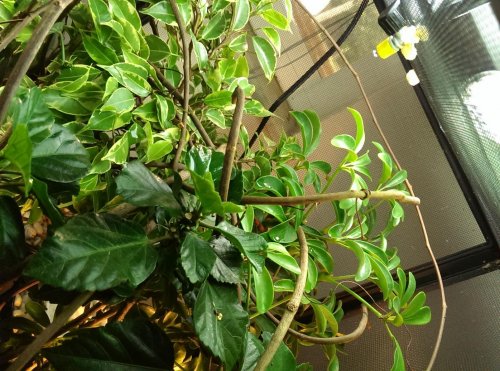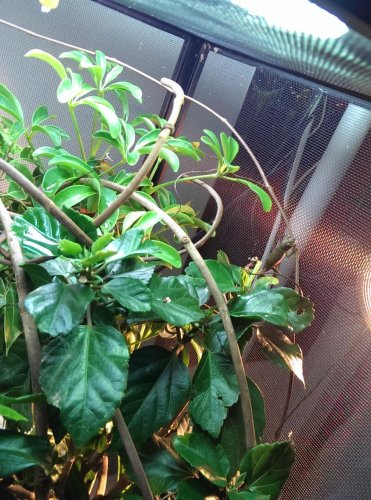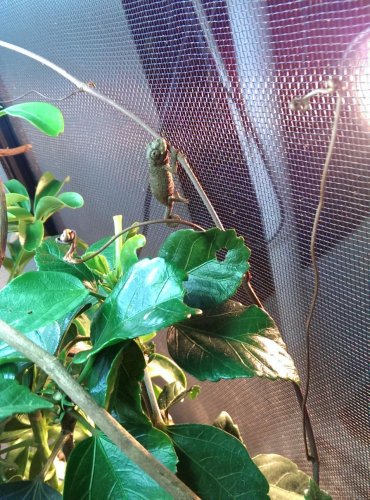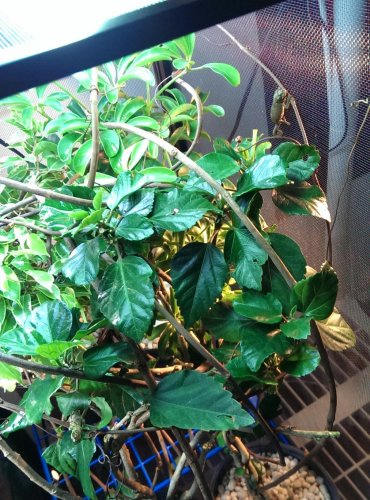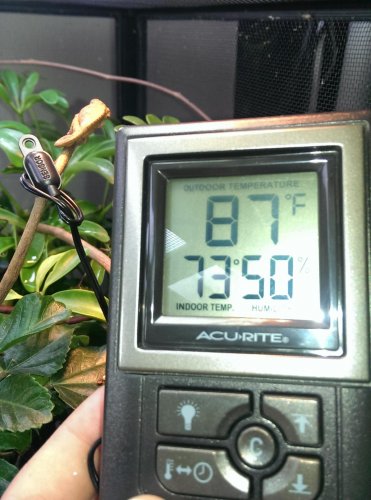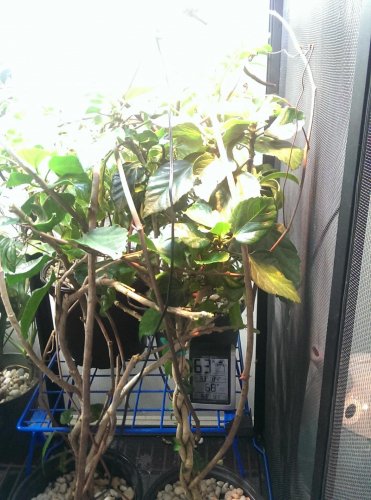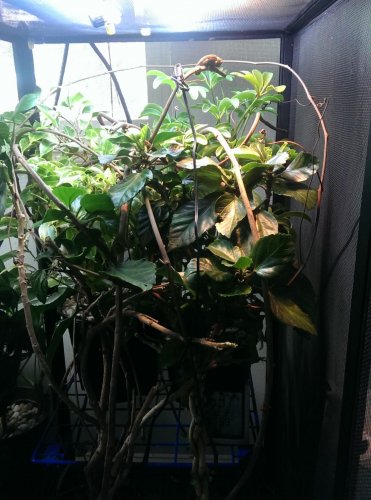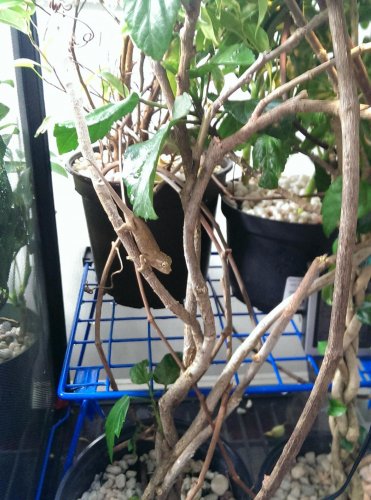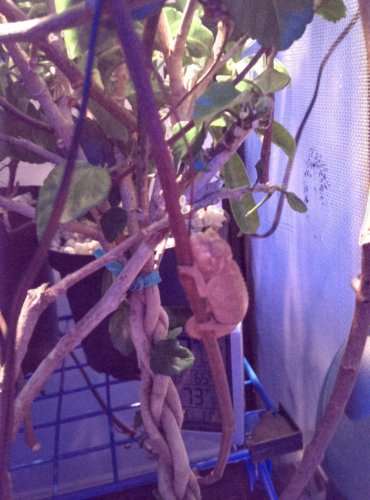Hello. My veiled chameleon seems to be hanging upside down with his tail balled up under the heat lam. It is a 40w basking light. Will he burn his tail. The temp under the lamp is about 90 degrees st the leaves. Should I get a stronger lamp. I know hes getting the heat to digest I clean his messes from the branches.
Navigation
Install the app
How to install the app on iOS
Follow along with the video below to see how to install our site as a web app on your home screen.
Note: This feature may not be available in some browsers.
More options
You are using an out of date browser. It may not display this or other websites correctly.
You should upgrade or use an alternative browser.
You should upgrade or use an alternative browser.
hanging
- Thread starter alil
- Start date
KingJulian
New Member
I know it is not uncommon for the babies to hang upside down under the light, however you do run the risk for burns. I would try to hang the light up off the cage.
jackschamnewbie
New Member
chameleon go durp
I think i tried doing the exact same thing to an extreme, and she is still never happy. Is this the type of thing your talking about? She has been walking on the ceiling most of the day catching crickets in the shaded corners.
I could not even begin to describe this type of behavior.
The young ones are picky and needy as hell. She seems to do this when provoked, frightened, pissed, hungry and when hunting.
I am hoping to catch one of the yawning, paw stomping, head waving and quietly hissing temper tantrums she throws for a variety of reasons. Like her breakfast being an hour late...
Usually she is very mild tempered and adventurous and pretty dope to interact with while feeding...

I think i tried doing the exact same thing to an extreme, and she is still never happy. Is this the type of thing your talking about? She has been walking on the ceiling most of the day catching crickets in the shaded corners.
I could not even begin to describe this type of behavior.
The young ones are picky and needy as hell. She seems to do this when provoked, frightened, pissed, hungry and when hunting.
I am hoping to catch one of the yawning, paw stomping, head waving and quietly hissing temper tantrums she throws for a variety of reasons. Like her breakfast being an hour late...
Usually she is very mild tempered and adventurous and pretty dope to interact with while feeding...
Attachments
Zephalia
Established Member
I also have a three and a half month old Panther and he does the same thing but only when he's T'd off at me. The few times I've handled him (I've had him for just over a week) he immediately crawls up there and sits directly under the lamp when I put him back. I end up removing the lamp until he moves away because I'm worried he will burn himself. Considering lifting the heat lamp off the cage a bit but if I leave him alone he doesn't go up there.
Oliviabryant
Member
Correct me if I'm wrong- but it looks as though your light is sitting on the top of the enclosure. This is a concern especially because your Cham climbs up there. I'm not sure if you have seen pictures of burns on chameleons but it happens during these types of instances. That or to high of a basking area. I would suggest buying a light stand to suspend your light above the cage so your little guy does not get burnt.
Here is a great source to look up common health issues with chameleons and they also have pictures to show you-
http://chamworld.blogspot.com/2008/01/health-chapter-f-burn.html?m=1
Here is the light stand you will want to purchase as soon as you are able to
http://lllreptile.com/store/catalog/reptile-supplies/light-fixtures/-/zoo-med-large-lamp-stand/
Here is a great source to look up common health issues with chameleons and they also have pictures to show you-
http://chamworld.blogspot.com/2008/01/health-chapter-f-burn.html?m=1
Here is the light stand you will want to purchase as soon as you are able to
http://lllreptile.com/store/catalog/reptile-supplies/light-fixtures/-/zoo-med-large-lamp-stand/
jackschamnewbie
New Member
The lights that you see near the top are the uvb bulbs.
1 reptiglo 18" linear 5.0; 1 reptisun CFL 5.0; and 1 zoomed CFL 5.0
all of which are 26w@5500K (tropical)
These are mounted into the utility shelf 2" from the top of the screen. An additional 5500k 26w high intensity CFL is at a 45º on the side helping with nursing sickly or sensitive plants.
The soft white light that she is trying to get closer to is a 40W mini incandescent spotlight, placed at a 45º8" from where she is seen laying.
The probe at the spot she is seen read 114º
The bulb that is the farthest away is still making the most heat.
Perhaps she likes to bask at this temp every now and again to help digestion or maybe she goes there when she gets rained on.
The probe and the screen are both black which absorb a lot of heat.
Her color changes from bown to lighter tan right before she moves from this area.
My educated guess is that when she changes to that pale tan color she is able to regulate the amount of radiant heat from light that she absorbs.
When the probe was turne d around to the white sticky side the temp sat at 82º for hours.
The uvbs' feel cool to the touch, computer fans do a great job of cooling it down. I sort of designed the top shelf/light hood to be this way
1 reptiglo 18" linear 5.0; 1 reptisun CFL 5.0; and 1 zoomed CFL 5.0
all of which are 26w@5500K (tropical)
These are mounted into the utility shelf 2" from the top of the screen. An additional 5500k 26w high intensity CFL is at a 45º on the side helping with nursing sickly or sensitive plants.
The soft white light that she is trying to get closer to is a 40W mini incandescent spotlight, placed at a 45º8" from where she is seen laying.
The probe at the spot she is seen read 114º
The bulb that is the farthest away is still making the most heat.
Perhaps she likes to bask at this temp every now and again to help digestion or maybe she goes there when she gets rained on.
The probe and the screen are both black which absorb a lot of heat.
Her color changes from bown to lighter tan right before she moves from this area.
My educated guess is that when she changes to that pale tan color she is able to regulate the amount of radiant heat from light that she absorbs.
When the probe was turne d around to the white sticky side the temp sat at 82º for hours.
The uvbs' feel cool to the touch, computer fans do a great job of cooling it down. I sort of designed the top shelf/light hood to be this way
camimom
New Member
The lights that you see near the top are the uvb bulbs.
1 reptiglo 18" linear 5.0; 1 reptisun CFL 5.0; and 1 zoomed CFL 5.0
all of which are 26w@5500K (tropical)
These are mounted into the utility shelf 2" from the top of the screen. An additional 5500k 26w high intensity CFL is at a 45º on the side helping with nursing sickly or sensitive plants.
The soft white light that she is trying to get closer to is a 40W mini incandescent spotlight, placed at a 45º8" from where she is seen laying.
The probe at the spot she is seen read 114º
The bulb that is the farthest away is still making the most heat.
Perhaps she likes to bask at this temp every now and again to help digestion or maybe she goes there when she gets rained on.
The probe and the screen are both black which absorb a lot of heat.
Her color changes from bown to lighter tan right before she moves from this area.
My educated guess is that when she changes to that pale tan color she is able to regulate the amount of radiant heat from light that she absorbs.
When the probe was turne d around to the white sticky side the temp sat at 82º for hours.
The uvbs' feel cool to the touch, computer fans do a great job of cooling it down. I sort of designed the top shelf/light hood to be this way
First off- you only need 1 UVB bulb. not 3.
SEcond- if her basking spot reads 114 F, you are roasting her!
Chameleons have a very hard time knowing when something is too hot.
SO she may sit under the light for a long time, and not realize shes getting burned.
Her basking temp should be no higher than 85 Deg F.
jackschamnewbie
New Member
First off- you only need 1 UVB bulb. not 3.
SEcond- if her basking spot reads 114 F, you are roasting her!
Chameleons have a very hard time knowing when something is too hot.
SO she may sit under the light for a long time, and not realize shes getting burned.
Her basking temp should be no higher than 85 Deg F.
Her basking spot sits at 82º ambient temperature. Ambient being that the thermometer is hanging in open air with a white colored probe facing the light.
Idk if you missed that part or what but any how...
The screen and anything dark in color absorbs and holds higher temperatures. if she wants to heat up or cool down in this area all she has to do is change her color, which she seems to be very good at. Perhaps they are more intelligent than you think...
Here is a picture if you are having a hard time understanding.
The outdoor temp is read by the probe seen next to where she is basking. The indoor temp and humidity are the ambient temp of my desk, 3' from her enclosure.
I would like to know why she likes to hang sideways though, as I cant seem to find any info on this.
I am guessing she is trying to warm the areas that the skin is closest to her blood vessels and veins but I cant be sure without proof. But maybe she is a bit retarded...
Oh! I forgot the uvb thing,
The definitive lighting thread posted by my favorite member of this site helped me reach the conclusion that in order to compensate for the uv dispersion rate as the distance increses between the bulb and the cham that 3 bulbs are just barely sufficient. Without a uv meter I will not know for certain but 4" from both uvb CFL's, 6" from the linear uvb and 8" from the basking light she should be getting ample uvb even through the screen.
87º on a black probe is pretty outstanding seeing how close to the lights she actually is. Based on the research I have done it is rather difficult to achieve these temperatures at this high of a uvb and lumen output.
Attachments
camimom
New Member
Just because she changes her color, doesn't mean she wont get burned. That's not how that works. Just because she may not be acting like shes too hot, it doesn't mean she isn't. Many a persons cham has been burned from a too hot basking spot, or by touching the screen when its too hot.
as for hanging sideways, she probably just likes to.
as for your 3 uvb bulbs, most of us use 1 bulb.
Too much uvb can hurt their eyes and make them shut them. while she may not be doing that now, it can happen in the future.
I use 1 reptiglo 10.0 tube style bulb in all my cages, and everyone is just fine.
The ambient temp and the basking temp are different.
You want the basking temp, which is her basking spot to be around 85, no higher.
Higher temps for females can lead to more egg laying and larger clutches, which shortens their life span.
as for hanging sideways, she probably just likes to.
as for your 3 uvb bulbs, most of us use 1 bulb.
Too much uvb can hurt their eyes and make them shut them. while she may not be doing that now, it can happen in the future.
I use 1 reptiglo 10.0 tube style bulb in all my cages, and everyone is just fine.
The ambient temp and the basking temp are different.
You want the basking temp, which is her basking spot to be around 85, no higher.
Higher temps for females can lead to more egg laying and larger clutches, which shortens their life span.
lancaster0861
New Member
Possibly she is trying to get to a cooler area of the cage while still maintaining the security by height. I notice a lot of cages offer cooler temps but only at lower levels in the cage. Another possibility is she is trying to get away from the mega red star of lights above her? Sure she could get some shade under the leaves, but again maybe she doesnt want to go lower in the enclosure. This may be her answer to the brightness. She gets out from directly under the lights but is still able to keep the height she wants within, or she gets out from under the mega star light but still takes advantage of the heat given in the upper part of the cage. Of course this could all be wrong, because im guessing there isnt many places in their that isn't directly lit up by the three uvb sources or growlights.....or heat lamp..... oh man ive just confused myself. Just some possibilities but I do hope u figure it out for her.
jackschamnewbie
New Member
Just because she changes her color, doesn't mean she wont get burned. That's not how that works. Just because she may not be acting like shes too hot, it doesn't mean she isn't. Many a persons cham has been burned from a too hot basking spot, or by touching the screen when its too hot.
as for hanging sideways, she probably just likes to.
as for your 3 uvb bulbs, most of us use 1 bulb.
Too much uvb can hurt their eyes and make them shut them. while she may not be doing that now, it can happen in the future.
I use 1 reptiglo 10.0 tube style bulb in all my cages, and everyone is just fine.
The ambient temp and the basking temp are different.
You want the basking temp, which is her basking spot to be around 85, no higher.
Higher temps for females can lead to more egg laying and larger clutches, which shortens their life span.
Jacksons dont lay eggs and she is scheduled for spraying next month to prevent health problems when she reaches sexual maturity.
Bobby Sue is in remission from a parasitic infection and it is completely normal to seek out higher temperatures. 87º on a black surface (80º on a white/tan surface or a relaxed chameleon colored surface) is only 2º higher than you believe is acceptable. Which for adult Jackson's is completely unacceptable. Basking for jacksons should never, ever exceed 80º and slightly less for adolescents. The vet explained that she might need the extra help digesting and healing and to provide her with a spot lamp to bask under if she responds well to it. Which she is, seen by the fact that she no longer clings to the screen for more heat.
Not trying to argue with you but honestly, I have done plenty of homework.
camimom
New Member
Jacksons dont lay eggs and she is scheduled for spraying next month to prevent health problems when she reaches sexual maturity.
Bobby Sue is in remission from a parasitic infection and it is completely normal to seek out higher temperatures. 87º on a black surface (80º on a white/tan surface or a relaxed chameleon colored surface) is only 2º higher than you believe is acceptable. Which for adult Jackson's is completely unacceptable. Basking for jacksons should never, ever exceed 80º and slightly less for adolescents. The vet explained that she might need the extra help digesting and healing and to provide her with a spot lamp to bask under if she responds well to it. Which she is, seen by the fact that she no longer clings to the screen for more heat.
Not trying to argue with you but honestly, I have done plenty of homework.
First off, you never said it was for a jacksons.
The OP had a question about a VEILED, when you responded, I assumed you were also discussing a VEILED.
Jacksons and veileds have very different care. and Yes I know jacksons don't lay eggs.
jackschamnewbie
New Member
Possibly she is trying to get to a cooler area of the cage while still maintaining the security by height. I notice a lot of cages offer cooler temps but only at lower levels in the cage. Another possibility is she is trying to get away from the mega red star of lights above her? Sure she could get some shade under the leaves, but again maybe she doesnt want to go lower in the enclosure. This may be her answer to the brightness. She gets out from directly under the lights but is still able to keep the height she wants within, or she gets out from under the mega star light but still takes advantage of the heat given in the upper part of the cage. Of course this could all be wrong, because im guessing there isnt many places in their that isn't directly lit up by the three uvb sources or growlights.....or heat lamp..... oh man ive just confused myself. Just some possibilities but I do hope u figure it out for her.
90% of the enclosure is in the shade, the way my camera adjusts the brightness and focus gives the impression that this is way to much light. I promise it is not.
Here is another couple pictures to show you what I mean. The first picture of the bottom half depicts the ambient temperature, the stages of the lower levels and what I have done to make it more appealing to her.
The second shows the contrast effect that my camera has when choosing which light scale I want to photograph. The enclosure is very densely vegetated, It takes me an average of 15 minutes to find her when she is in the forested area(s)
Attachments
jackschamnewbie
New Member
First off, you never said it was for a jacksons.
The OP had a question about a VEILED, when you responded, I assumed you were also discussing a VEILED.
Jacksons and veileds have very different care. and Yes I know jacksons don't lay eggs.
Veiled chameleons like hotter temps, which is why I made the advice that I did. I am not going to sit her and justify my reasoning for making the suggestions that I have.
The fact that my jackson does the same thing when given the temps I provide displays the theory that some creatures are just more picky and for what ever reason want to be a bit warmer.
The cookie cutter info sheets you are pulling your argument from is out dated and in some cases simply wrong.
85 is on the cold side for basking veiled chams, and as I am sure some of you have seen they will climb as close to the heat source as possible in this case.
Some husbandry practices that are considered a gold standard do not always apply. What works for me may not work for you. The species of jackson I have originated from and is genetically programmed to function best at an elevation 2,000 metres (6,562 ft) with an average humidity of 60% and a wet season that soaks the vegitation and wild life to death in some cases for half of the year.
I live in the front range at the base of the rocky mountains, 5,280 ft above the sea with an average humidity of 2% and temps in the high 90º's this time of year. I could not imagine a worse place to be keeping a montane species. It has been 95º outside and 0% humidity for months.
The amount of variables to considered before reasonably calling you out on being wrong is too vast for me to attempt. Thank you for your input though!
lancaster0861
New Member
I understand she has plenty of vegatation, but im saying that maybe she doesnt want to go lower in the cage to get to the shade. Maybe she wants to keep the height and get away from the lights, I guess iff all else fails just add another light!
jackschamnewbie
New Member
I understand she has plenty of vegatation, but im saying that maybe she doesnt want to go lower in the cage to get to the shade. Maybe she wants to keep the height and get away from the lights, I guess iff all else fails just add another light!
lol I think another light might be EXTREME overkill.
However I assumed the possibility of what you said to be true, at one time.
Things like that are majorly the causes of numerous trial an error experiments which eventually reasoned this enclosure to go above and beyond what is needed. There is always room for improvement though
The dense vegetation helps her feel more safe and secure as well as providing more surface area for her to move around and gain muscle. Live plants have helped retain humidity within the enclosure and give the insects places to hide so they do not crawl around or intimidate her.
Controlling the feeders is my current problem. I have no time to watch whether she eats or not besides a time lapse from a web cam that is limited to the middle section of her cage. Hand and cup fed legless crickets, fruit flies or super/horn worms are all gut loaded and supplemented with non phospho calcium without d3.
I watch her eat some free range crickets and count how many crickets are found dead, how many are visibly living in the corners and on foliage and how many I put in there to begin with. I hate leaving insects in the cage with her when I am gone but I have no other means of keeping her full and active.
She does move around the entire enclosure throughout the day though, either hunting or adjusting her temperature.
For example right now she is in predator mode playing the whole, "I am but a lump on a stick, you do not see me" sort of thing.
She sleeps in about the same area as well
The weird thing is every time she is stimulated or perhaps not feeling well she clings to the hottest part of the cage. it is as if she is trying or hoping to escape into the reflection of her enclosure in the adjacent mirror.
Theory is based off the amount of time she spends on the screen closest to the plant nursery.
This theory is of coarse contradicted by her climbing on the ceiling directly under the uvb lights, while the basking lamp is turned off.
I believe this is relative to the temperatures within the enclosure.
When it is in the low 60's on the cool dry side she can be found on that tippy top branch or crawling on the ceiling. when it is in the low 70's she can be found hunting along the bottom.
Most people find this behavior in young chams of all species so I assume it is just normal?
Attachments
Djturna4thakidz
Established Member
Yeah I think you need to tighten up the husbandry a little bit. 3 lights is very excessive and can hurt their eyes. If you dont think you are getting enough light, switch to the 10.0. but only one UVB is recommended and sufficient. I use t5 because my cages are 5 foot in height.
Young chameleons often hang from various locations in the cage. it will subside once they get older.
It is great that you are doing plenty of homework, keep it up!
Young chameleons often hang from various locations in the cage. it will subside once they get older.
It is great that you are doing plenty of homework, keep it up!
lancaster0861
New Member
Yea the light thing of course was just a joke as I only prefer one light, but like u said it could just very well be that she is just walking around and likes that spot. I know u seem to be pretty set on your current light set up but have u by chance just tried only one uvb, and watched her behavior? I only say that just because that seems to work great for almost everyone.
jackschamnewbie
New Member
Yeah I think you need to tighten up the husbandry a little bit. 3 lights is very excessive and can hurt their eyes. If you dont think you are getting enough light, switch to the 10.0. but only one UVB is recommended and sufficient. I use t5 because my cages are 5 foot in height.
Young chameleons often hang from various locations in the cage. it will subside once they get older.
It is great that you are doing plenty of homework, keep it up!
3 is excessive? I thought that having to pass through the screen would significantly decrease the uvb and uva that reaches the enclosure. Based on what ive read in a post by ChameleoPatrick -> https://www.chameleonforums.com/definitive-lighting-thread-everything-you-really-need-know-80869/
I was under the assumption that this was not nearly enough.
I did not want to listen to a word he said as I despise this person with a passion, but he made some damn good points.
The bulbs came with out put readings showing negligible uvb beyond 9" and nearly non existent at 12". The basking spots are all 3"-10" from the bulbs in top 3/4 of the canopy.
The visible light from the uvb's is incredibly less that of the spot light and extremely less than the typical CFL I use for nursing sickly plants. I double checked and the light I use for the plants is a Feit Electric 18W 5500k. This light only puts out 1170Lumens and like I stated above is significantly brighter than the uvbs and the spot light combined. I cannot find the lumen output of either of the uvb bulbs or I would include this information as well.
What you are saying would make sense if it was the uv spectrum that was hurting their eyes and not the lumen out-put.
However like you said yourself the 5.0's don't exactly have remarkable ratings.
There was a recall issued for reptiglow 5.0 and 10.0 uvb's roughly 4 years ago. They were interestingly putting out uv spectrums that do not occur naturally and were causing snow blindness.
Sorting through this vast amount of info online and deciding fact from fiction is rather confusing honestly.
An interesting response was written by Dave Weldon, co-founder of the south bay chameleon keepers group, explains what I think you(and many many others) have based this belief from. In the article he wrote;
"The situation with CFL UVB lights (and UVB sources in general) is always changing and up-to-date information is sometimes difficult to obtain. Manufacturers have been known to change their phosphor recipes resulting in deadly UV output levels (power level measured in uW/cm2 and also UV Index levels) as well as deadly spectral content. Often times they don't have the right equipment to understand the dangers related to these changes until the reptile community begins to correlate the poor health conditions (photo-kerato-conjunctivitis [snow blindness]) and even death (documented UVB burns) resulting from these products. At best, some manufacturers have begrudgingly stopped distributing these products but very rarely ever actually pulled the product from the pet store shelves. ZooMed responded fairly well when it was discovered that their Reptisun 10.0 CFL and to a lesser extent their Reptisun 5.0 CFL were found to be producing non-terrestrial spectral content (parts of the UVB spectrum that don't normally reach the earth's surface [think: hole in the ozone!]) that caused photo-kerato-conjunctivitis. They eventually re-formulated their CFL phosphor recipe and fixed the problem. These CFLs can be identified by the date code in the lower right corner of the instruction sheet. If it is dated 2009 then it is ok and if it is dated 2006 then it should not be used.
As far as the Exo Terra Repti Glo 5.0 CFL, there is some evidence that may indicate that their product lines, including their linear tubes and mercury vapor lamps may be in question since they have, yet again, switched manufacturers for some of these products and phosphor formulations may be in question.
My advice, along with the majority of the chameleon keeping world, is to use the ZooMed Reptisun 5.0 LINEAR tube in any of the lengths from 18", 24", 36", 48" (18 and 48 being the most popular) and position it at the proper distance (usually around 6"-12") from the basking spot.
For those who have not been there yet:
https://www.chameleonforums.com
http://www.uvguide.co.uk/
http://pets.groups.yahoo.com/group/UVB_M…
See Ya, Dave Weldon
Co-founder of the South Bay Chameleon Keepers group (Los Angeles area)"
Similar threads
- Replies
- 2
- Views
- 1K
- Replies
- 8
- Views
- 1K
- Replies
- 16
- Views
- 3K
- Replies
- 5
- Views
- 1K

